Final Fantasy V On Windows 95 (Interview)
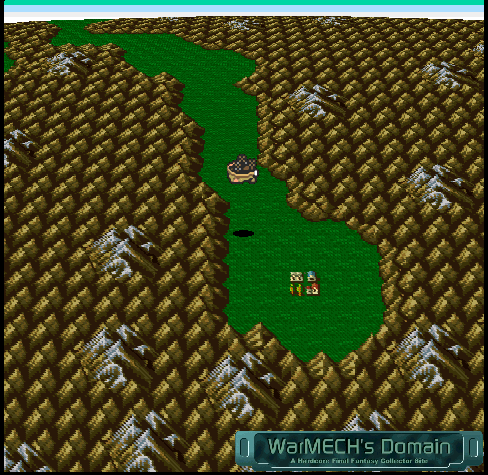
Marcelo X: Please tell my viewers a little something about
yourselves and how you all came to work for Top Dog.
William Ivey: It all started in the dim, dark, past. Aka, 1991. Moved to Austin because I
liked the town. Started looking for a job so I could stay here and found an ad
for a programmer with 6502 assembly experience. Turned out to be Origin Systems
and the job was programming a Super Nintendo (SNES) game; a port of
"Ultima VII, The Black Gate." (I still have a cartridge - one of the
few games I worked on that saw the light of retail.) I was at Origin when it
was bought by Electronic Arts (I still own one share of EA).
Eventually Origin dropped its carts department (and me) and I moved on to
SimTex where I worked on "Masters of Orion II" for a while. They were
bought by Microprose while I was there (maybe I'm good luck?).
The guy I'd worked for at Origin called me one day to come interview at Top Dog
on a port of a SNES game to the PC. That sounded like more fun than MOO II was
turning out to be, so I dusted off my SNES knowledge and changed horses. This
would turn out to be my last game job (don't you hate such in-your-face
foreshadowing?).
Tony Duncan: I had wanted to be a game programmer since I was ten, specifically, I
wanted to work at Origin Systems with Richard Garriott on an Ultima. While I
was in my senior year in college, I had been doing searches of the Austin area
for game companies that were hiring. I came across Top Dog which stated that
they had worked with Origin on various projects. I talked to my wife about
submitting a resume. Thinking that nothing would come of it, she said "go
ahead." I sent them my handy-dandy demo and they did a phone interview.
They hired me the next day, asking how fast I could get to Texas. We were there
two weeks later. My wife is still telling me that I've moved her to a different
planet.
Marcelo X: Are any of you now or have you ever been a fan of the Final Fantasy series?
Ryan Wolfe: I haven't really played any of the FF games.
William Ivey: No. Not really a fan of RPGs in any form as a player, but I did like
to program
them, especially tile-based versions.
Tony Duncan: Until I got to Top Dog, I had not heard of FF5, but I was a big fan of role
playing games in general, so I was excited to work on this project. I snapped
up FF7 for the PlayStation and played through it in any available free
time. The intricate storylines more than made up for what I originally thought
was a drawback: I wasn't happy that I couldn't go anywhere I wanted to whenever
I wanted to like in most Ultima's.
Marcelo X: How did the Final Fantasy V project come into existence, was it Square or
Eidos that hired Top Dog Software to port it?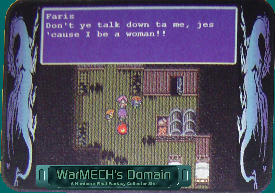
Ryan Wolfe: I'm fairly certain it was Square (the California office) that was running the project. They hired Top Dog to port the Japanese version of the game. We were given the source code and the English translations for in-game stuff. If I recall correctly, the code itself was only documented in Japanese (which none of us at Top Dog spoke) so it was extremely difficult to figure out what was going on inside the program. I think this was the cause of the delays that lead to me being moved part-time onto the project.
William Ivey: Square. Happened before I got there though.
Tony Duncan: I can't say for certain, but I believe another company we were working for
introduced us to SquareSoft. I could be wrong on that one, though.
Marcelo X: What were your roles in the development of the software?
William Ivey: Tech lead, I guess. I focused on the graphics tile/sprite engine initially.
Being able to emulate the SNES's graphics in software was kind of key to being
able to do the game at all. We used DirectX to get an image buffer but I wrote
my own optimized blitter routines. (There were a lot of blitters - optimized
for specific sized regions, special effects such as color blends, etc.)
It was a natural role since, of the people working on the project, I had the
most experience with the SNES's internals.
If you've never seen the guts of a SNES, it's a set of custom graphics hardware
hung around a 65816 CPU - big brother to the 6502 of Apple II fame. There are
dozens of graphic modes and thousands of combinations (and plenty of quirks and
gotchas, too). Everything is controlled by lots of registers which respond in
various strange and wonderful ways.
There are two approaches to porting a game from the SNES to PC: 1)
emulate the SNES in detail and just dump the game cart's contents into your
emulator, or; 2) analyze the game and reproduce it functionally. We chose the
latter since it promised better results on the target machine and there are
just so many modes it's hard to get an emulator right. Might have been a
mistake, but...
Tony Duncan: My primary role was the event system and most of the non-battle
user-interface.
Marcelo X: How was the Japanese to English translation handled, in house or by Square?
Tony Duncan: A wonderful Japanese woman flew to Austin and worked with us for about two
months. She played the original Nintendo version with the VCR going and
translated the text so we knew what was going on. We also had Square provide us
with a translation of the text to use within the English version of the game.
Marcelo X: Why was the project cancelled?
William Ivey: Short answer: It went out of control.
Mistakes were made, communications from Austin to California to Japan and back
were problematic, and we didn't get all the documentation we should have early
on. (We didn't even know it existed until very late in the game, so to speak.)
That led to false starts, delays and other problems that are familiar to most
programmers and project managers, but worse than usual in this case.
Tony Duncan: I'll go with Bill's answer.
Marcelo X: How much of the game was completed before it was cancelled?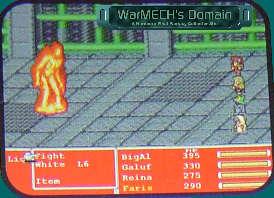
William Ivey: Seemed like a lot. I know there were still problems although I don't remember
the specifics. The combat engine was a tough nut. There were many issues with
"passability" - the areas of the map the players could and could not
walk through which required manual touching up. (One of my first, ever,
legitimate Windows GUI applications was a map editor for this purpose.) Some
art issues due to not being clear on what layers went where (lack of
documentation on that).
Other things like that. But it looked "real" and played. I had fun
wandering around in the "world."
Tony Duncan: There was a belief at the time that we were about two months away from
completion. In hindsight, it was probably closer to six months.
Marcelo X: Was the cancellation of FF5 associated with the
unfortunate demise of Top Dog Software?
Ryan Wolfe:
The cancellation did not directly contribute to the death of Top Dog, though it might have been one of several contributing factors. The fall was caused by a long series of projects being cancelled - mainly the result of giant publishers taking advantage of small development houses (make them bid low and agree to a ridiculous schedule, then throw a fit when the schedule slips).
Marcelo X: What was changed from the original version when ported to Windows? Were any
other features added to this port?
Ryan Wolfe: I don't think much was changed for the port other than technical details and translating. The map thing (both a world map, and the "3D" flying one) I did from scratch and don't recall seeing an example in-game. So if anything was new, that was probably it.
William Ivey: Not much, really. We were working at the source and data level so what was
there stayed there.
Marcelo X: Was the game going to run in a window or full screen? At which resolution(s)?
Ryan Wolfe: The resolution fit the PC (probably 640x480)
full screen.
William Ivey: It was full screen at 640 by 480 as I recall, but framed since it didn't fill
out the screen from side to side at 512 by 480 displayed pixels. (The SNES
would have run it at 256 x 220 if I recall the specs correctly.)
Marcelo X: Did the PC version have the Full Motion Videos that the PlayStation version had
implemented?
Ryan Wolfe: If there were full-motion videos, I never saw them (which is possible, that code may not have been ported yet).
William Ivey: Run as AVI files I think (or maybe .flc files, or both, I don't remember for
sure).
Marcelo X: Was the game censored in any way for the U.S. market?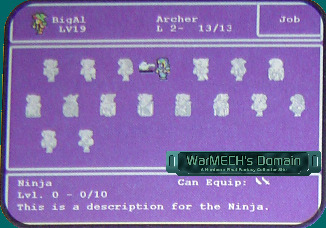
Ryan Wolfe:
I don't recall anyone mentioning censoring the material. Then again, I don't recall seeing anything that required censorship either.
William Ivey: Not that I know of - we went with whatever was in the source code and files we
were given.
Marcelo X: Were the graphics a direct port or modified to fit a different resolution?
William Ivey: We took the original art and doubled it in each direction with some smoothing
using a custom tool on the tiles. That didn't alter the relationships of the
art, just doubled each dimension. (That made the map 512 pixels on a side, but
it was still 32 tiles square.) Each visible tile was usually a stack of
several layers so we had lots of tile art files (and, initially, not much clue
as to which ones went together; that made for some funky looking displays).
Marcelo X: I know none of you worked for Eidos, but I've heard that the game was going
to be sold on their website and downloadable from it, can any of you verify this?
Ryan Wolfe:
I hadn't heard about the game being sold on a website, or any connection to Eidos at all. I think that Eidos came into the picture right at the end (or precipitated the end) of the project. I also vaguely recall that Square (or maybe Eidos by then) took the project away to finish it "in house" somewhere in California, and then later cancelled it altogether. I'm not certain on that, but it seems the lead programmer was flown out there once or twice to help with the transfer.
William Ivey: Never heard of that - I assumed it was going to be shrink-wrapped and sold.
Marcelo X: Is there any inside information that most people would find interesting about
this project?
William Ivey: From my point of view the most interesting bits are all technical and probably
kind of boring to most people. (For one thing, most of the things you can say
about a tile-based RPG have probably been said too many times.)
Tony Duncan: Possibly an amusing story... even though the QA people at SquareSoft
weren't amused by it. I forgot the exact circumstances, but there was a part in
the game where the group was on top of a mountain with the dragon. They are
chatting for a while and then go to the dragon to fly away. Under a certain set
of circumstances, the dragon would reach down and snap off Lenna / Reina's head
and it would roll away. Butz / Bartz would then yell out "You Bastard!!!
You killed Reina!!!" Then everything would restore itself and the game
would continue. When the QA people found it the first time, they tried and
tried to make it happen again. After that, I was called into the product
manager's office to discuss their displeasure.
Marcelo X: Do any of you have any information on the Final Fantasy VI PC version that was
announced to follow Final Fantasy V? Was that project ever started? If yes, how
far along was it?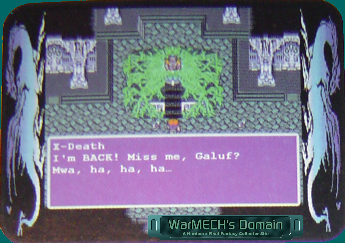
Tony Duncan: If I recall, the company that originally introduced us to SquareSoft was
working on FF6. Beyond that, I couldn't tell you.
Marcelo X: Is there anything you guys would like to add that I didn't touch upon or anything in
general about yourselves or Top Dog?
William Ivey: I worked with some really great and
interesting people and look back on it with a certain fondness. There are days
I think about going back into game development, but I have to remind myself
that was then, and this is now (I get paid better now and I've developed a
fondness for Unix systems).
Tony Duncan: It was a great bunch of people. I would have liked to see it continue.
Marcelo X: Thank you all very much for taking the time to answer these questions, I'm sure
many fans will be grateful for your inside information on this lost
Final Fantasy port.
William Ivey: Hey, you're welcome! Wish I had more
"top level" information but that wasn't something I was involved in.
Tony Duncan: No problem.